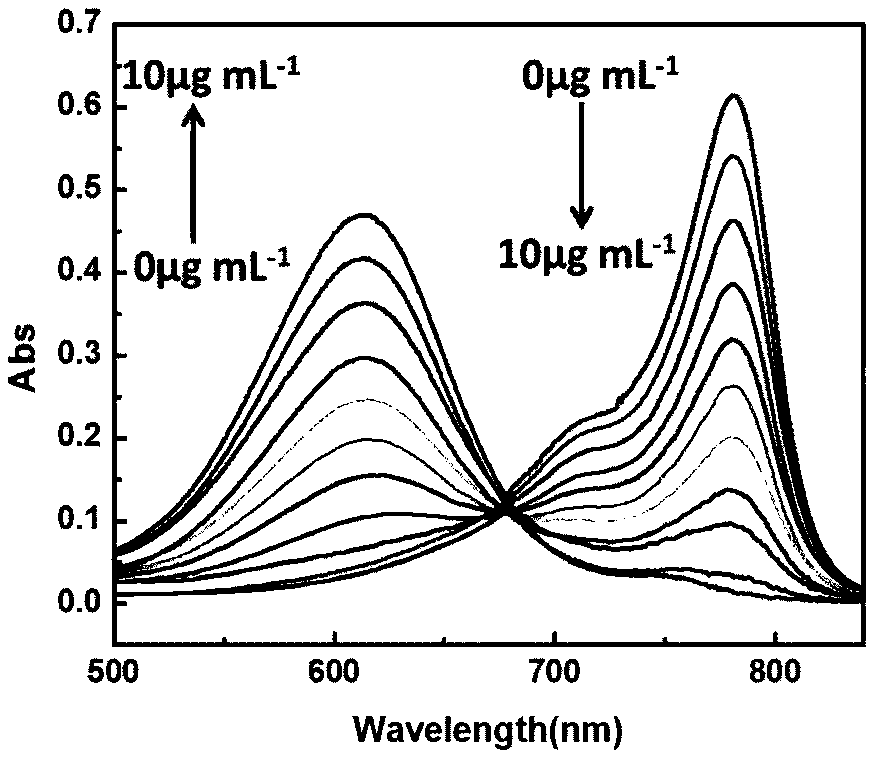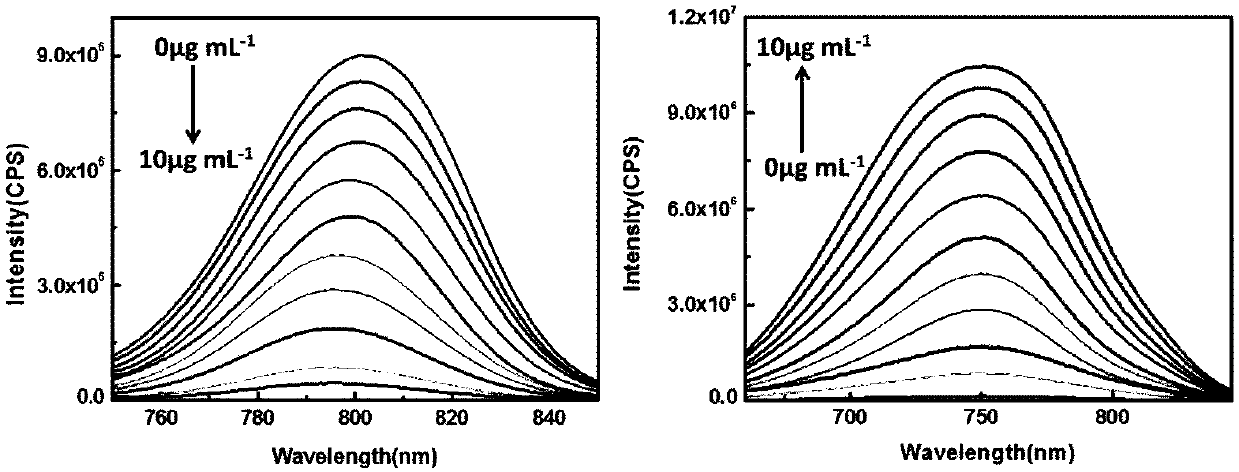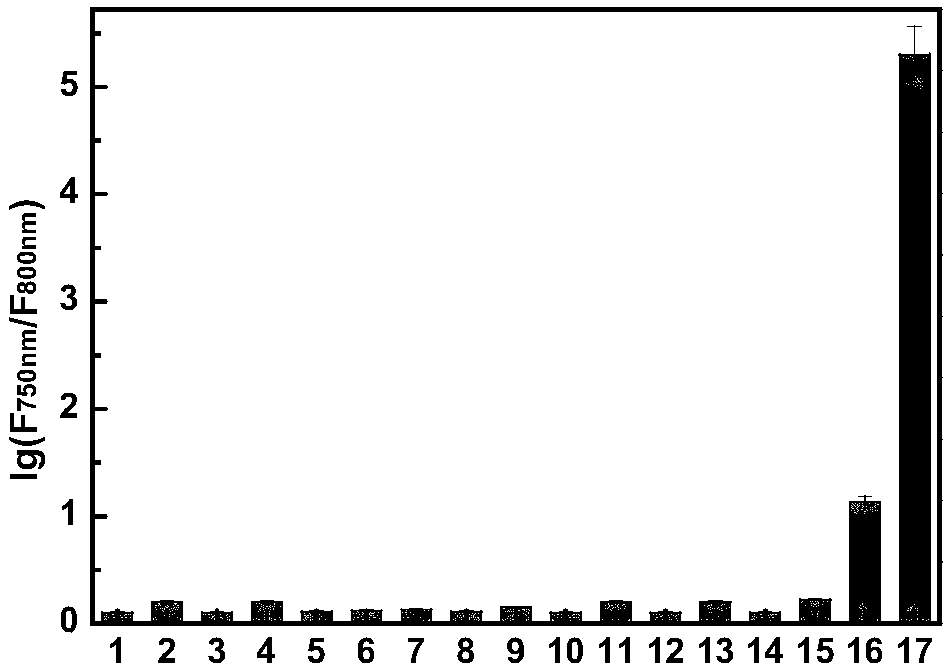Organic compound based on cyanine and application of organic compound
A technology for organic compounds and organisms, applied in the field of detection of monoamine oxidase, which can solve the problems of damage to biological samples, inability to effectively avoid biological autofluorescence interference, and large photobleaching effect of organisms.
- Summary
- Abstract
- Description
- Claims
- Application Information
AI Technical Summary
Problems solved by technology
Method used
Image
Examples
Embodiment 1
[0028] Preparation of organic compound of formula I based on cyanine:
[0029] (1) Preparation of Compound 1
[0030] Under the protection of argon, (4-bromobutyl)triphenylphosphine bromide (14.35g, 30mmol) and sodium azide (3.9g, 60mmol) were dissolved in 50mL DMF. Stir overnight at 90°C. The color of the solution ranges from colorless to light yellow to red. The reaction flask was cooled to room temperature, and 50 mL of dichloromethane was added until a large amount of precipitation occurred. Filter and collect the filtrate. The collected filtrate was extracted with ethyl acetate and water 1:1 (v / v), and the organic phase was collected and rotary evaporated. Put the product after rotary evaporation into a round bottom flask, install a reflux device, stir, add about 7.5 ml of dichloromethane to make it completely dissolved, heat to a solution temperature of about 40°C, and reflux. When the solution boiled slightly, ethyl acetate was added to make the solution white crys...
Embodiment 2
[0052] The prepared compound of formula I is used as a probe to detect MAO-A in cells, tissues and organs, and to simulate physiological conditions. The following experiments are all carried out under pH=7.4 conditions (HEPES buffer solution, concentration is 40mM), The probe concentration was 10 μM.
[0053] The ultraviolet response of the compound formula I prepared above to MAO-A:
[0054] pH was controlled with HEPES buffer solution. Add the compound of formula I to a 10mL colorimetric tube to ensure its final concentration is 10μM, then add 40mM HEPES, then add MAO-A, add 10mL of ultrapure water to make the concentration of MAO-A respectively 0μg mL -1 , 1 μg mL -1 , 2 μg mL -1 , 3 μg mL -1 , 4 μg mL -1 , 5 μg mL -1 , 6 μg mL -1 , 7 μg mL -1 , 8 μg mL -1 , 9 μg mL -1 , 10 μg mL -1 . Shake the solution and equilibrate for 60 minutes, then add the above working solution into the cuvette to measure the ultraviolet absorption spectrum. The changes of the ultravio...
Embodiment 3
[0058] The fluorescence response of the compound of formula I to MAO-A:
[0059] pH was controlled with HEPES buffer solution. Add the compound of formula I to a 10mL colorimetric tube to ensure its final concentration is 10μM, then add 40mM HEPES, then add MAO-A, add 10mL of ultrapure water to make the concentration of MAO-A respectively 0μg mL -1 , 1 μg mL -1 , 2 μg mL -1 , 3 μg mL -1 , 4 μg mL -1 , 5 μg mL -1 , 6 μg mL -1 , 7 μg mL -1 , 8 μg mL -1 , 9 μg mL -1 , 10 μg mL -1 . Shake the solution evenly and equilibrate for 60 minutes, then add the above working solution into the fluorescence dish to measure the fluorescence spectrum. The changes of fluorescence spectrum before and after detection of MAO-A are as follows: figure 2 shown. The compound of formula I can be used to realize the detection of MAO-A in organisms.
[0060] Depend on figure 2 Indicates the change of fluorescence intensity of the system with the change of MAO-A concentration, indicating th...
PUM
 Login to View More
Login to View More Abstract
Description
Claims
Application Information
 Login to View More
Login to View More - R&D
- Intellectual Property
- Life Sciences
- Materials
- Tech Scout
- Unparalleled Data Quality
- Higher Quality Content
- 60% Fewer Hallucinations
Browse by: Latest US Patents, China's latest patents, Technical Efficacy Thesaurus, Application Domain, Technology Topic, Popular Technical Reports.
© 2025 PatSnap. All rights reserved.Legal|Privacy policy|Modern Slavery Act Transparency Statement|Sitemap|About US| Contact US: help@patsnap.com



